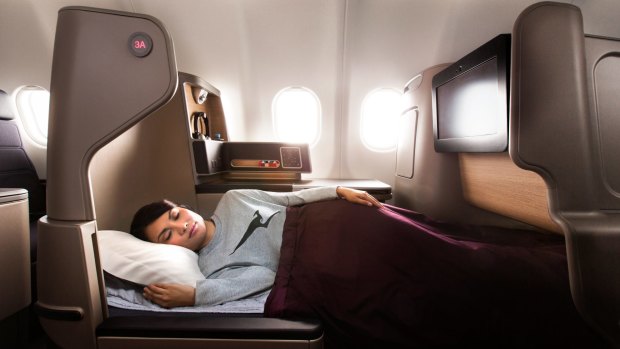This was published 6 years ago
Jet lag: What causes it and how to get over it
By Michael Gebicki
Jet lag. We all suffer from it, but like so many of life's small afflictions – poverty in one's youth, taxes – jet lag affects the rich classes less.
Even though a flyer in business class is crossing exactly the same number of time zones as those in sardine class, there's every chance they will cope better with jet lag. There's the soothing environment of the business class lounge, the stress-free, no-wait boarding, a wide and well-padded seat with heaps of legroom if this is a long-haul flight.

World first: Qatar's double beds in Business Class can help passengers cope better with jet lag.
That seat will probably morph into a lie-flat bed, and most airlines allow their business class flyers to dine on demand, with the opportunity to sleep, work, eat and watch the inflight entertainment to their own schedule. Savvy business-class travellers will tailor all of the above to chime with the arrival time at their destination, jump-starting their adjustment to a new time zone.
Cross four time zones or more and you can expect to feel the effects of jet lag. South-east Australia keeps Eastern Standard Time, GMT plus 10 hours. Travelling west, if your final destination is anywhere in India (GMT+5.5 hours) or further west and you can expect to experience jet lag. Between March 31 and October 30, the period when daylight savings no longer prevails in Victoria and NSW, a trip to Hawaii involves a time change of five hours. Fly there or anywhere further to the east and you can expect a few difficult nights.
Sleep experts reckon your brain and body can only adapt to a new time zone at the rate of about one hour per day. In a worst-case scenario, such as a trip to Europe, east coast US or South America, that means disrupted sleep patterns for a week.

Business class on board Qantas.Credit: Brent Winstone
Flying east is worse than flying west. The reason, according to researchers, is that our circadian rhythm, the internal body clock that tells us when to sleep and when to get up – is slightly longer than 24 hours. We find it easier to stay up a couple of hours longer at night than we do to rise two hours earlier in the morning. Therefore, the theory goes, travelling west, and hitting the sack at a later hour, comes more naturally than the early wake-up when you travel in an easterly direction.
The big-ticket item that tells our bodies when to wake up is the bright light of a new day. We have evolved as hunter-gatherers who operate most effectively in daylight. After a long flight, experts recommend we use that morning light to synchronise our brains with local time. If you hit Europe shortly after dawn, which is when many flights from Australia arrive, the best thing you can do to help adjust your body clock to local time is to take a stroll outdoors as soon as possible. If you reach your destination in mid-afternoon or later, you want to tell your body it's time to start winding down, and a couple of hours in full sunshine is not in your interests.
Even with the right exposure to light, adjustment to a new time zone can't happen quickly. The reason is a protein, SIK1, which counteracts the impact of light on the brain, slowing down the process of adaptation. When SIK1 became part of the process of human evolution, mother nature wasn't considering the impact of long distance travel in the jet age.
There are a couple of online jet lag calculators based on the principle of strategic light exposure and avoidance to overcome jet lag. One is the Jet Lag Rooster, jetlagrooster.com, another is the Jet Lag Advisor from British Airways, britishairways.com/travel/drsleep.
Another strategy is starvation. This is based on the idea that our bodies have a second clock set not by daylight but by the time we eat. When food is scarce, this clock overrides the circadian clock, instructs the body to sleep less and resets when we start eating again.
There's an intuitive appeal to this theory since in times of food scarcity, it would be in the interests of our hunter-gatherer ancestors to spend less time in the cave and more hours out biffing mastodons.
Based on this concept, back in the 1980s following experiments on rats and his own eight offspring, Charles Ehret, a molecular biologist of some renown, devised the Argonne Anti Jet Lag Diet. For several days before a long-haul flight, Ehret suggested that long-distance flyers alternate days of normal meals with next-to-nothing days. On flight day, the traveller would eat lightly but then chow down on a big breakfast to coincide with early morning in the destination time zone.
The US military, CIA, Canadian National Swim Team, and Mormon Tabernacle Choir have all used the Argonne Diet and reported less serious jet lag, but given freedom of choice, starvation is never a popular option and the diet has failed to gain traction.
A more appealing solution is the anti-jet lag fast invented by the Harvard and Beth Israel Deaconess Medical Centre in Boston. Using this method, the traveller fasts for 12-16 hours before breakfast time at the destination. Since most of us have no trouble dieting between dinner and breakfast that shouldn't be a stretch, although it might mean saying "No" when the meal trolley rumbles down the aisle, and on a long flight that takes real willpower.
Another jet lag beater is building a stopover into your trip, even if it's a short one. Professor Dorothy Bruck, emeritus professor of psychology at the College of Health and Biomedicine, Victoria University, Melbourne, says: "Having a two day stopover when flying from Australia to Europe allows your body clock to move closer to the time at your European destination."
Europe-bound flyers in particular now have a big choice of stopover options, with the Middle East ports of Doha, Abu Dhabi and Dubai now added to the traditional favourites of Singapore, Hong Kong, Bangkok and Kuala Lumpur. Sri Lanka is yet another option via non-stop flights from Melbourne to Colombo with SriLankan Airlines, and Perth is yet another option for east coast flyers when Qantas kicks off its non-stop Perth-London flight in March 2018.
Our understanding of the circadian rhythm took a great leap forward last year when three American researchers, Jeffrey Hall at the University of Maine, Michael Rosbash at Brandeis University, and Michael Young at the Rockefeller University, were awarded the 2017 Nobel prize in physiology or medicine for their decades-long work on the circadian clock. Their work sheds light on a fundamental mechanism, namely how our cells can keep time. Harnessing that knowledge, and coming up with a remedy that helps us overcome jet lag more quickly, is probably still many flights away,
See also: Dreamliner v Airbus A350 - which plane is better on a long haul flight
See also: The foods you need to avoid when flying
Sign up for the Traveller newsletter
The latest travel news, tips and inspiration delivered to your inbox. Sign up now.